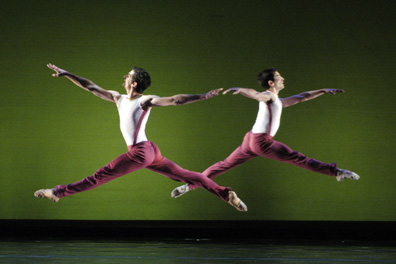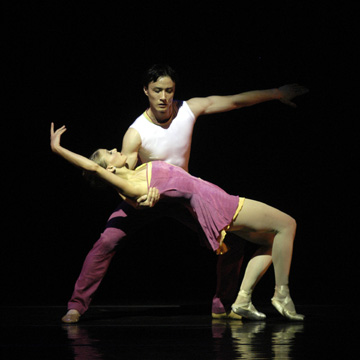Popular Fare
Concerto
Caprice, Sting/ING Situations, Lost and Found
Pittsburgh Ballet Theatre
Filene Center, Wolf Trap National Park for the Performing Arts
Vienna, Virginia, USA
August 24, 2004
By
George Jackson
copyright
© 2004 by George Jackson
published August 30, 2004
 Mention
the Pittsburgh Ballet Theatre to Washington dancegoers who have memories
going back 8 seasons and they'll recall a piece of Americana, a baseball
ballet the company brought to Wolf Trap. No one, though, seems to remember
much about the work, only that Patricia Wilde was artistic director then
and people were surprised that this Balanchine alumna so wasted her dancers'
time and that of the audience. This time, ahead of time, people were wondering
whether Ms. Wilde's successor, Terrence S. Orr—known from his years
as a leading character artist with American Ballet Theatre—was following
in her footsteps. Two of the ballets for Wolf Trap would have scores by
the rock star Sting. After so many failed attempts everywhere to do ballet
to music other than that of the classical tradition, haven't company directors
learned better? Ballet evolved to classical music and the kinship holds
almost as much for modern dance despite some exceptions—Paul Taylor's
"Company B" (with singing by the Andrews Sisters) and, to a
degree, Twyla Tharp's "Sinatra Songs".
Mention
the Pittsburgh Ballet Theatre to Washington dancegoers who have memories
going back 8 seasons and they'll recall a piece of Americana, a baseball
ballet the company brought to Wolf Trap. No one, though, seems to remember
much about the work, only that Patricia Wilde was artistic director then
and people were surprised that this Balanchine alumna so wasted her dancers'
time and that of the audience. This time, ahead of time, people were wondering
whether Ms. Wilde's successor, Terrence S. Orr—known from his years
as a leading character artist with American Ballet Theatre—was following
in her footsteps. Two of the ballets for Wolf Trap would have scores by
the rock star Sting. After so many failed attempts everywhere to do ballet
to music other than that of the classical tradition, haven't company directors
learned better? Ballet evolved to classical music and the kinship holds
almost as much for modern dance despite some exceptions—Paul Taylor's
"Company B" (with singing by the Andrews Sisters) and, to a
degree, Twyla Tharp's "Sinatra Songs".
At the start of the program one could postpone thinking about Sting because
Wolf Trap had commissioned a new work from what the printed program termed
an emerging choreographer, Susan Shields. She is local, from the Washington
area, and started out classical. After an apprenticeship with Mary Day's
Washington Ballet, Ms. Shields danced in modern companies, but those of
choreographers or directors who were balletically trained—Laura
Dean, Lar Lubovitch, Mark Morris, Jacek Luminski, Mikhail Baryshnikov.
Currently, she is on George Mason University's faculty.
 Ms.
Shields's choice of music was a winner, a rhythmically vivid concerto
grosso that almost sounds 18th Century but is by a 20th Century American
composer trained in Italy, Vittorio Giannini. The title of the new ballet,
"Concerto Caprice", rings trite though the piece itself isn't.
The first movement out of three is fleet, fresh, vivid. Twelve dancers
are positioned in a rectangular formation, four people wide by three deep,
with airy aisles between bodies. The number of women equals the number
of men. Like the music, in which different instruments become prominent
singly or in distinct combinations and then merge with the ensemble as
others come to the fore, diverse dancers step into and out of the limelight.
Ms. Shields is no copycat, but influences come to mind. Think of a triangle
with corners consisting of Mr. Morris's bouncy musicality (as in "Gloria"),
George Balanchine's formal sparkle (as in "Concerto Barocco")
and Harald Lander's exhilerating sense of show-off (as in "Etudes"),
then the "Concerto Caprice" choreography would be at the geometric
center.
Ms.
Shields's choice of music was a winner, a rhythmically vivid concerto
grosso that almost sounds 18th Century but is by a 20th Century American
composer trained in Italy, Vittorio Giannini. The title of the new ballet,
"Concerto Caprice", rings trite though the piece itself isn't.
The first movement out of three is fleet, fresh, vivid. Twelve dancers
are positioned in a rectangular formation, four people wide by three deep,
with airy aisles between bodies. The number of women equals the number
of men. Like the music, in which different instruments become prominent
singly or in distinct combinations and then merge with the ensemble as
others come to the fore, diverse dancers step into and out of the limelight.
Ms. Shields is no copycat, but influences come to mind. Think of a triangle
with corners consisting of Mr. Morris's bouncy musicality (as in "Gloria"),
George Balanchine's formal sparkle (as in "Concerto Barocco")
and Harald Lander's exhilerating sense of show-off (as in "Etudes"),
then the "Concerto Caprice" choreography would be at the geometric
center.
 The
second movement, an adagio, is too busy. There are entrances and exits
galore. The purpose still is to highlight a succession of different soloists,
but the effect is one of visual fragmentation. It is contrary to the music's
slow and sustained flow. Perhaps, Ms. Shields might have avoided the distracting
comings and goings if another influence had come into play—Leonide
Massine's symphonic technique in which the dominant movement line is passed
from one group of dancers to another and the initial dancers don't disappear
but become subsidiary.
The
second movement, an adagio, is too busy. There are entrances and exits
galore. The purpose still is to highlight a succession of different soloists,
but the effect is one of visual fragmentation. It is contrary to the music's
slow and sustained flow. Perhaps, Ms. Shields might have avoided the distracting
comings and goings if another influence had come into play—Leonide
Massine's symphonic technique in which the dominant movement line is passed
from one group of dancers to another and the initial dancers don't disappear
but become subsidiary.
The Shields ballet's fast finale works well again, both visually and musically,
even though it isn't as tight or bold as the beginning. All in all, I
look forward to seeing this piece again and to the choreographer's future
commissions. Janet Marie Groom's costumes, raspberry sorbet and white,
and Barbara E. Thompson's stylish but unmannered lighting let one see
the dance action clearly.
Sting's music sounds—to my ear—slick, shallow and unvaried.
Although the choreography by Kevin O'Day for the second of the two pieces
to Sting song collections was interesting enough that I could shut out
the whiney-voiced musical renditions, there was little to recommend the
first piece, Matjash Mrozewski's "Lost and Found". One section,
a trio to just instrumental sound that was danced by two men and a woman,
started developing. Then another man entered, the whining began and dance
invention ceased. Mr. Morozewski was working in a balletic style but his
step combinations were pedestrian, his dynamics tepid, his dramatics predictable.
Some sort of visual story tied the songs together, with Erin Halloran
as a knowing woman in a mauve gown, Jennifer Langenstein as a vulnerable
innocent in a white dress and the yellow-clad Kaori Ogasawara as a heedless
female among assorted males. Martha Graham told it better.
"Sting/ING Situations" isn't a ballet in the strict sense. Mr.
O'Day uses a ballet modern base to do disco dancing. Bodies are loose,
the movement intertwined, the mood is sullen at times, the effect raunchy.
Adding to the sensuality are Mark Zappone's see-through costumes, generally
black net above the waist and sheer black stretch cloth below. Much anatomy
shows (though groins are covered, in some instances it is by an underlayer
of prominent white). Good bodies are important to spinning out the movement
sequences, and this company has them. There's more, though, than sexuality
that's appealing about Mr. O'Day's work. He explores the approaches dancers
take when working out and improvising, and also the mood swings that skew
their physical logic.
By current standards, Pittsburgh Ballet Theatre's roster of 30 or so is
remarkably uniform in size and shape. Trained by Marianna Tcherkassky
(fomer Mary Day student and ABT principal, also Mrs. Orr) and Steven Annegarn
(from Britain's Royal Ballet institutions) assisted by Dana Arey and Roberto
Munoz, the dancers move as an ensemble. Maribel Modrono, who appeared
in Ms. Shields's ballet, has a distinctive glamor.
Photos, all from Susan Shields's "Concerto Caprice," are by Scott Suchman
Originally
published:
www.danceviewtimes.com
Volume 2, No. 33
August 30, 2004
Copyright
©2004 by George Jackson
|
|
|